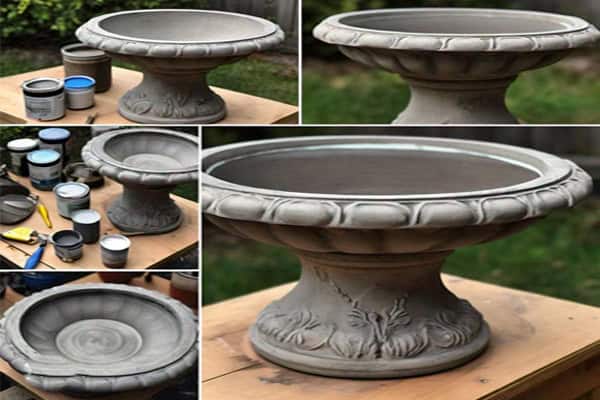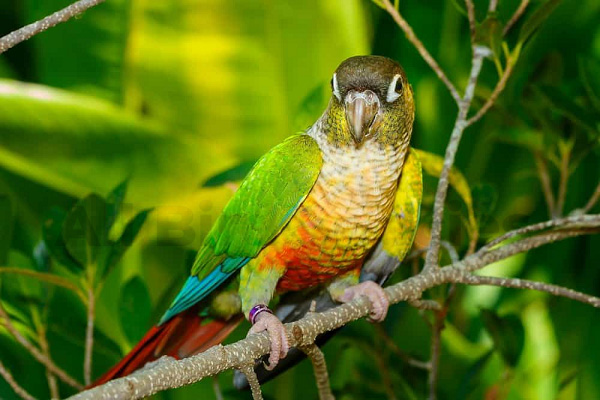Bird Bath Guide: Choosing a Bird Bath That Birds Actually Use
Choosing a bird bath might seem straightforward at first, but the variety of options can make it overwhelming. To simplify the process, I’ve put together the ultimate bird bath guide to eliminate any confusion.
If you’re interested in selecting a bird bath that will attract and delight wild birds, take a look at the key questions you should consider before making a purchase.
Before purchasing a bird bath, here are some essential questions to consider
Why should you purchase a bird bath?
If you reside in a typical suburban or urban area, a bird bath is likely to attract more birds than your feeders. This is because birds have a diverse diet, not solely reliant on seeds. Depending on the season and species, birds may consume insects or utilize other food sources.
Bird baths consistently draw birds to your yard because
1. All Birds Need To Drink
It’s a fact that certain bird species seldom visit feeders. Consider the robin, for instance; I’ve never spotted them at any of my feeders, yet they frequent the bird bath.
However, all birds require water. By offering a fresh water source, you’ll attract birds to your yard throughout the day.
In many residential areas, landscaping is well-kept, but often, the nearest source of fresh water is quite a distance away. Birds in your neighborhood will opt for your bird bath over a stagnant puddle on the sidewalk.
2. Birds Like Daily Baths
Bird baths are crucial for birds because they aid in maintaining their feather condition. Since birds molt their feathers only twice a year, they must keep them in excellent shape between molts.
Although the science isn’t entirely conclusive, it’s believed that bathing helps remove mites that can damage feathers, redistributes the feathers’ protective oils, and realigns the feathers’ barbs, ensuring effective flight and predator evasion.
That’s a plethora of benefits derived from just a shallow pool of water.

Can wild birds drink tap water?
In most parts of the United States, tap water is safe for human consumption. If your local water is safe for you, then it’s safe for wild birds too.
Normally, wild birds might drink from puddles or other freshwater sources that could contain high levels of bacteria. By offering them a supply of clean, fresh water, you’re aiding in keeping them hydrated and healthy which is very helpful.
What’s the best bird bath to get?
he best bird bath for you is the one you’ll clean and maintain regularly.
I understand that may not be the specific answer you were expecting, but the ideal bird bath varies for each individual and yard.
At its core, bird baths require regular cleaning and refilling. Consider your current habits and routine to help determine the bird bath that will suit you best.
Below, I’ll get into more detail about the different materials and styles of bird baths available, so you can narrow down your search.
Best Material For Bird Baths
When selecting a bird bath, consider the material it’s made of, as each material has its own advantages and may suit your yard or lifestyle better than others. Here are some typical bird bath materials:
1. Different Materials:
Bird baths can be made from various materials. Here are some common ones:
- Concrete: Sturdy and durable, but may need more cleaning.
- Plastic: Easy to maintain and long-lasting.
- Glass: Looks beautiful but can be fragile.
- Glazed Pottery: Naturally stays cleaner.
- Copper: Resistant to algae growth.
- Bronze: Adds elegance but requires care.
2. Copper Benefits:
- Copper bird baths are less likely to have algae because of their biostatic properties.
- However, remember that too much copper can be harmful, especially for marine life and fish.
3. Maintenance Matters:
- Consider how often you’ll clean the bird bath. Choose a material that suits your cleaning routine.
Which is the best color for a bird bath?
You have the freedom to choose any color for your bird bath. Different bird species are naturally attracted to specific colors, usually as a signal for food sources. You can incorporate these colors into your bird bath or, more effectively, in the plants you cultivate in your bird-friendly garden.
Here are some of the best colors to attract birds:
- Yellow: Attracts Hummingbirds, Warblers, and Goldfinches.
- Blue: Appeals to Bluebirds and Blue Jays.
- Red/Pink: Draws in Hummingbirds.
- Orange: Attracts Hummingbirds and Orioles.
However, there is one color you should avoid: White. White is often used in plumage as a warning color and can inadvertently startle or scare birds away.
What style of bird bath do you prefer?
Bird baths are available in various styles and designs, and the choice ultimately depends on your preference. Let’s explore some common styles along with their pros and cons:
1. Classic Pedestal:
- Description: This style features a wide, heavy basin balanced on top of a pedestal with a stabilizing base.
- Pros: Birds easily recognize and use this type of bath. It’s stable and can withstand storms and high winds, especially if made of concrete.
- Cons: Concrete versions can be heavy and cumbersome to clean and refill. Once set up, they’re not easily moved around.
2. Deck Mounted
- Description: Deck-mounted baths attach to your deck in various ways, such as clamping onto the railing or being screwed directly into the deck.
- Pros: Ideal for apartment dwellers or those with limited outdoor space, allowing for close-up views of local wild birds. The bath’s proximity to the house makes it easier to remember to refill and clean. Basins often detach for easy cleaning indoors.
- Cons: Birds attracted to the deck may lead to bird droppings in the area, requiring regular cleaning.
3. Hanging
Hanging bird baths are like plants hanging from the air. They have smaller basins than other bird baths.
Moreover, you can hang them from a pole connected to your apartment balcony, which is great if you don’t have much outdoor space. You can also easily bring them inside to clean them in your kitchen sink.
Furthermore, like the baths that sit on decks, hanging baths attract birds to your balcony, so you’ll have to clean up bird droppings. Additionally, you’ll need to take it down when it’s windy because some birds don’t like it when the bath moves around a lot.
4. Low/Ground Dwelling
Surprisingly, this might be the most preferred bird bath for wild birds. It’s called a ground bath because it’s either low to the ground or directly on it.
Wild birds usually bathe in puddles they find on the ground. This bath style closely imitates their natural bathing habits.
Having a ground bath will also attract other birds that live on the ground. Additionally, you might start seeing other animals like raccoons, opossums, and rabbits.
To see who’s using your bath, you can set up a night vision camera that starts recording when it detects movement.
Another good thing about this type of bath is that it’s lightweight and easy to move around. You can try it out in different spots before deciding where to keep it.
Assessing A Bird Bath’s Functionality
When picking out a bird bath, it’s crucial to consider how well it works. Sometimes, people choose a bath just because it looks nice without thinking about how well it will work for the birds.
They forget to think about the most important features. When you’re trying to decide between two bird baths, always prioritize how well it works over how it looks.
You can find baths that are both functional and nicely designed. Before making a decision, think about these two questions:
How is the bowl designed?
The shape of the bowl is the most crucial factor in attracting or deterring birds.
Different bird species have different preferences. Tall birds prefer deeper water, while small birds with short legs need shallow pools.
The best bowl design ideally starts shallow at the edges and gradually becomes deeper, reaching a maximum depth of 3 inches in the middle.
Is the basin easy to clean?
Here’s a question to consider that you’ll appreciate later on: How easy is it to keep the bird bath clean and filled with fresh water?
The toughest part of maintaining a bird bath is making sure it stays clean and has clean water. Birds won’t be interested if the water is still or covered in algae. Plus, dirty water can make birds sick!
Do yourself a favor and choose a bird bath that you find easy to clean and take care of.
Why do birds poop in the bird bath?
Birds are light animals with hollow bones, which helps them stay as light as possible for flying.
When a bird uses a bird bath, it adds weight to its body with water. This triggers a natural response in their bodies to get rid of any extra weight, hence the pooping.
Though it can be frustrating to constantly clean bird poop out of the bath, it’s actually an adaptation that keeps wild birds safe and ready to fly away quickly if needed.
Why Aren’t Birds Using My Bird Bath?
1. Depth Matters
Bird baths are often designed to look nice, but sometimes they’re too deep for our feathered friends. It’s better to have a bath that’s too shallow than one that’s too deep.
- Ideal Depth: A proper bird bath should have a maximum water depth of 3 inches. The center of the bath is usually the deepest, while the edges are more shallow. This way, many bird species can enjoy it.
- Watch Out: Birds can drown in deep baths. To prevent this, choose a bath with a gradual slope and avoid slippery surfaces.
- Quick Fix: If you already have a deep bath, add rocks or bricks to make it shallower.
2. Keep It Steady
A wobbly bird bath can scare birds away. Depending on the type of bath you have:
- Pedestal or Ground Bath: Place it on level stones.
- Deck-Mounted or Hanging Bath: Find a less windy spot.
3. Location Matters
Where you put your bird bath matters too:
- Open Yard: If your bath is in the middle of an open yard without nearby shrubbery, it might be too exposed. Songbirds like having nearby brush for safety.
- Test Different Spots: Try moving the bath around to see where birds use it most.
4. Keep It Cool
Hot water isn’t inviting for birds:
- Shady Spot: Place your bird bath in the shadiest part of your yard. This prevents water from evaporating too quickly.
- Mid-Day Water Change: If it’s still too warm, change the water in the late afternoon. Birds are most active in the morning and evening.
5. Cleanliness Is Key
Birds won’t use a dirty bath:
- Algae, Stagnant Water, and Bird Poop: Regularly change the water, even if it looks clean.
6. Watch Out for Predators
If everything else is right, consider predators:
- Stray Cats: They might hang around bird feeders or baths.
- Owls or Hawks: Check if there’s a nearby nest.
By addressing these factors, you’ll create a bird-friendly oasis in your yard.
Can Bird Baths Be Used in Winter?
1. Types of Bird Baths
- Decorative Bird Baths: These are often delicate and can’t handle freezing temperatures. Examples include glass, bird bath fountains, mosaic designs, solar bird baths, and glazed pottery. It’s best to store these away during winter and bring them out in spring.
- Concrete Bird Baths: Even concrete baths may not withstand the damage caused by freezing and expanding water. If you live in a climate with freezing temperatures or ice storms, consider swapping out concrete bird baths for the winter.
- Cold-Resistant Materials: Plastic, metal, or fiberglass bird baths can withstand the cold and can be modified to prevent freezing.
2. Heaters and De-Icers
- Heating Elements: If your birdbath tends to freeze over during cold weather, consider adding a bird bath heater. These plug-in devices are submerged into the middle of the bird bath, preventing the water from completely icing over.
By choosing the right type of bird bath and using heaters or de-icers, you can provide a refreshing water source for birds even during winter.
Do birds like bird bath fountains?
Absolutely, birds are attracted to bird bath fountains. The sound of flowing water is like a magnet for them. They’ll hear it and come check it out. While standing water is good, moving water is even better for attracting wild birds.
You can also add moving water to your bird bath with misters, drippers, artificial ponds, or streams.
How to convert a bird bath into a fountain
Transforming your bird bath into a fountain is a fun project! Here’s a simple guide to do it:
- Choose a Solar-Powered Fountain Pump: This is the easiest way to add a fountain feature to your bird bath. These pumps are eco-friendly and require no batteries.
- Place the Pump in the Bird Bath: Just put the solar-powered pump in the water. The solar panels will collect sunlight and power the pump to create a fountain.
- Check the Size: Ensure your bird bath is big enough for birds to enjoy a bath even with the fountain pump inside.
- Enjoy the View: Once set up, you can enjoy watching birds play in the new fountain!
Remember, the key is to make sure the bird bath remains a comfortable and safe place for birds to bathe and drink while adding the charm of a fountain.
Concerns About Attracting Wildlife
Some people worry about whether their bird bath will attract unwanted wildlife.
At night, you might see harmless creatures like raccoons, opossums, or rabbits, especially in more rural areas where you might even spot deer, coyotes, and more.
Snakes and Bird Baths:
- Snakes do drink water, but they usually prefer less exposed spots than a raised bird feeder. They won’t be specifically attracted to bird baths.
- If you have best bird feeders nearby that attract mice or rats, snakes might come to prey on them. In this case, having snakes around can actually be beneficial for rodent control.
Mosquitoes and Bird Baths:
- Mosquitoes are attracted to stagnant water for laying their eggs. Regularly changing the water in your bird bath is essential.
- To discourage mosquitoes, consider adding a solar fountain to your bird bath. The movement of water will make it less suitable for mosquito breeding.
Remember, maintaining a clean and inviting bird bath benefits the birds while minimizing unwanted wildlife
You Can Read Our Previous Articles
| Top 25 Best Gifts For Bird Lovers |
| How to Get Kids Interested in Birdwatching |
| Where Do Hummingbirds Sleep at Night |
| What Time Do Birds Wake Up? |
| White Birds In Michigan |
Frequently Asked Questions
Q1: How to set up a successful bird bath?
Choose a shady spot, keep it clean, and ensure a stable base. Provide fresh water regularly.
Q2: What attracts birds to a bird bath?
Moving water, shallow depths, and nearby cover like trees or shrubs attract birds. Clean water is a must.
Q3: How many times should a bird bath?
Clean the bird bath daily, especially in warmer months, and refill it as needed to maintain water freshness.
Q4: What is the best depth for a bird bath?
Aim for depths of 1-3 inches, allowing birds to bathe safely without fear of drowning.
Q5: What color attracts birds to a bird bath?
Natural colors like browns and greens blend well with the environment and attract birds more effectively.






